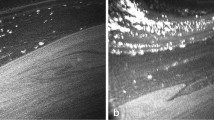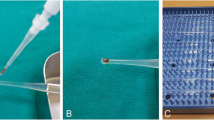Abstract
As a new proposal, natural tears collected from the Schirmer strips were studied using surface pressure-area, π-A, isotherms obtained with the Langmuir technique. Parameters such as limit surface pressure, πlimit, elastic modulus at the maximum, CS−1max, and surface pressure at the maximum, πmax, were correlated with clinical tests, such as the Schirmer (SCH) and the tear film breakup-time (TFBUT) tests. The analysis from the chi-square test indicates dependence between the SCH test and the type of isotherms with a value of P < 0.05. A moderate Pearson correlation coefficient with statistical significance (P < 0.05) between the values of the SCH test and the πlimit was obtained. On the other hand, a low Pearson correlation coefficient with no statistical significance (P > 0.05) between the values of the TFBUT test and the πlimit was obtained. Additionally, considering only the isotherms classified as good, moderate Pearson correlation coefficients with statistical significance (P < 0.05) between the values of the TFBUT test and πlimit or πmax can be obtained. This study shows that the isotherms obtained with the Langmuir technique correlate well with the tear secretion, and when the later is moderate or good, the isotherm parameters afford information about the tear film stability and the behaviour of the tear lipids.




Similar content being viewed by others
References
Kaercher, T., Hönig, D., & Möbius, D. (1993). Brewster angle microscopy. A new method of visualizing the spreading of Meibomian lipids. Internat Ophthalmol, 17, 341–348.
Kaercher, T., Hönig, D., & Möbius, D. (1995). Meibomian lipid layers seen through BAM. Orbit, 14, 17–24.
Hagedorn, S., Drolle, E., Lorentz, H., Srinivasan, S., Leonenko, Z., & Jones, L. (2015). Atomic force microscopy and Langmuir-Blodgett monolayer technique to assess contact lens deposits and human meibum extracts. J Optom, 8, 187–199.
Petrov, P. G., Thompson, J. M., Abdul Rahman, I. B., Ellis, R. E., Green, E. M., Miano, F., & Winlove, C. P. (2007). Two-dimensional order in mammalian pre-ocular tear film. Experimental Eye Research, 84, 1140–1146.
Mudgil, P., & Millar, T. J. (2011). Surfactant properties of human Meibomian lipids. Investigative Ophthalmology & Visual Science, 52, 1661–1670.
Mudgil, P., Torres, M., & Millar, T. J. (2006). Adsorption of lysozyme to phospholipid and Meibomian lipid monolayer films. Colloids and Surfaces, B: Biointerfaces, 48, 128–137.
Miano, F., Calcara, M., Millar, T. J., & Enea, V. (2005). Insertion of tear proteins in a Meibomian lipids film. Colloids and Surfaces, B: Biointerfaces, 44, 49–55.
Svitova, T. F., & Lin, M. C. (2016). Dynamic interfacial properties of human tear-lipid films and their interactions with model-tear proteins in vitro. Advances in Colloid and Interface Science, 233, 4–24.
Millar, T. J., Mudgil, P., Butovich, I. A., & Palaniappan, C. K. (2009). Adsorption of human tear lipocalin to human Meibomian lipid films. Investigative Ophthalmology & Visual Science, 50, 140–151.
Saad-Bhamla, M., Chai, C., Rabiah, N. I., Frostad, J. M., & Fuller, G. G. (2016). Instability and breakup of model tear films. Investigative Ophthalmology & Visual Science, 57, 949–958.
Torrent-Burgués, J. (2016). Langmuir films study on lipid-containing artificial tears. Colloids and Surfaces, B: Biointerfaces, 140, 185–188.
Korb, D. R. (2002). The tear film: structure, function and clinical examination. Oxford: Butterworth Heinemann.
Bron, A. J., Tiffany, J. M., Gouveia, S. M., Yokoi, N., & Voon, L. W. (2004). Functional aspects of the tear film lipid layer. Experimental Eye Research, 78, 347–360.
DEWS. (2007). Report of the dry eye workshop. The Ocular Surface, 5, 75–92 and 93-107.
Cho, P., & Yap, M. (1993). Schirmer test I. A review. Optometry and Vision Science, 70, 152–156.
Behrens, A., Doyle, J. J., & Chuck, R. S. (2006). Dysfunctional tear syndrome: a Delphi approach to treatment recommendations. Cornea, 25, 900–907.
Savini, G., Prabhawasat, P., Kojima, T., Grueterich, M., Espana, E., & Goto, E. (2008). The challenge of dry eye diagnosis. Clinical Ophthalmology, 2, 31–55.
Torrent-Burgués, J. (2011). Oleamide and oleamide-lipid mixed monolayers. BioNanoSci, 1, 202–209.
Davies, J. T., & Rideal, E. K. (1993). Interfacial phenomena. N.Y: Academic Press.
Vitovic, P., Nikolelis, D. P., & Hianik, T. (2006). Study of calix[4]resorcinarene-dopamine complexation in mixed phospholipid monolayers at the air/water interface. Biochimica et Biophysica Acta, 1758, 1852–1861.
Gai, M., Frueh, J., Tao, T., Petrov, A. V., Petrov, V. V., Shesterikov, E. V., Tverdokhlebov, S. I., & Sukhorukov, G. B. (2017). Polylactic acid nano- and microchamber arrays for encapsulation of small hydrophilic molecules featuring drug release via high intensity focused ultrasound. Nanoscale, 9, 7063–7070.
Stuart, M. C., Huck, W. T. S., Genzer, J., Müller, M., Ober, C., Stamm, M., Sukhorukov, G. B., Szleifer, I., Tsukruk, V. V., Urban, M., Winnik, F., Zauscher, S., Luzinov, I., & Minko, S. (2010). Emerging applications of stimuli-responsive polymer materials. Nature Materials, 9, 101–113.
Matteini, P., Ratto, F., Rossi, F., & Pini, R. (2012). Emerging concepts of laser-activated nanoparticles for tissue bonding. Journal of Biomedical Optics, 17, 10701.
Mencucci, R., Boccalini, C., Caputo, R., & Favuzz, E. (2015). Effect of hyaluronic acid and carboxymethylcellulose ophthalmic solution on ocular comfort and tear-film instability after cataract surgery. Journal of Cataract and Refractive Surgery, 41, 1699–1704.
Acknowledgements
The authors thank MSc C. Fàbregas and MSc M. Pérez for providing the clinical results.
Author information
Authors and Affiliations
Corresponding author
Rights and permissions
About this article
Cite this article
Guaus, E., Torrent-Burgués, J. The Langmuir Technique Applied to the Study of Natural Tears. BioNanoSci. 8, 559–565 (2018). https://doi.org/10.1007/s12668-018-0509-4
Published:
Issue Date:
DOI: https://doi.org/10.1007/s12668-018-0509-4




